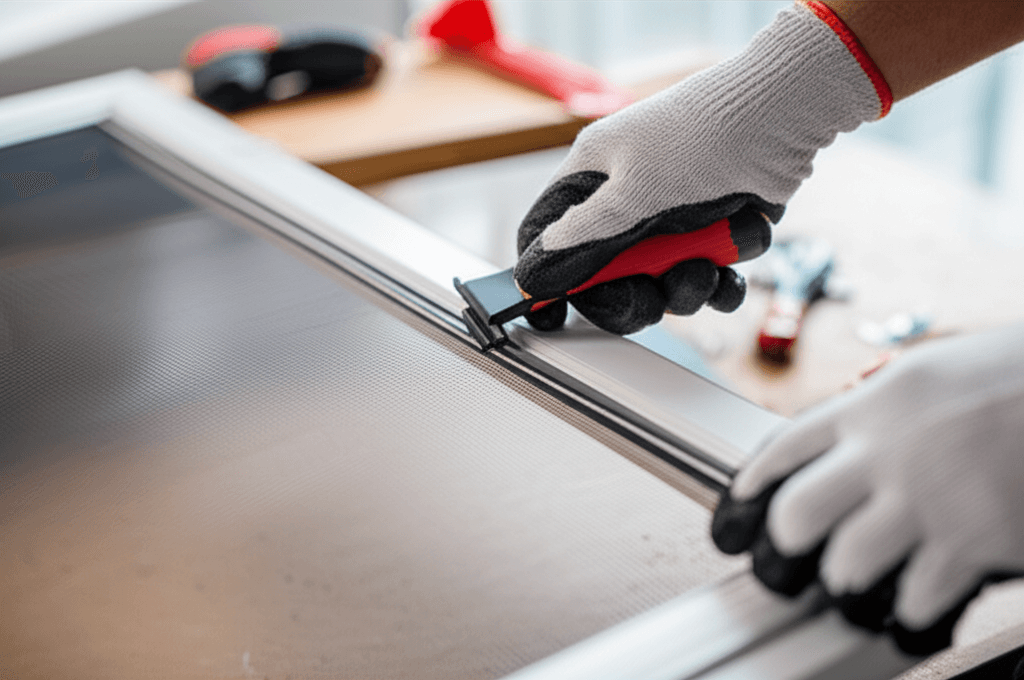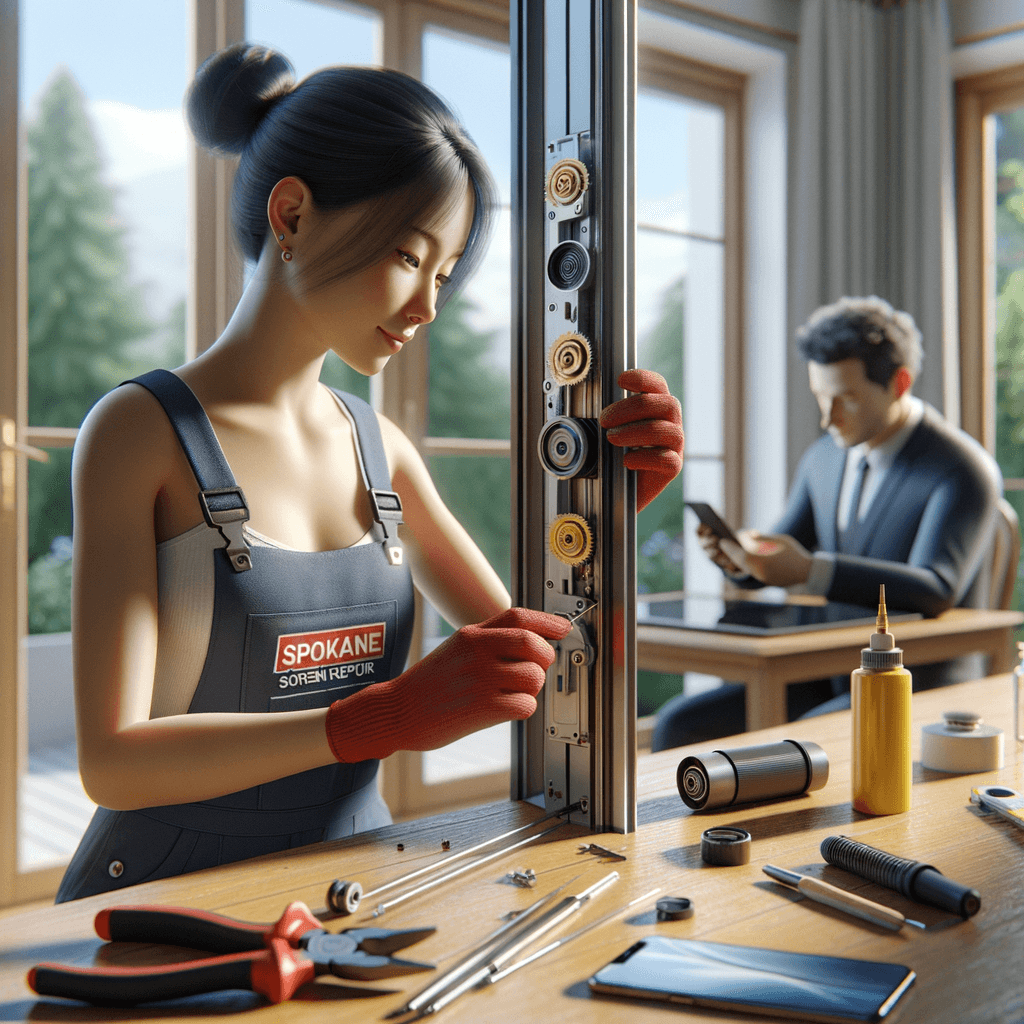
Replacing Window Screen Without Spline? Read This First!
Wondering if you can replace a window screen without spline? While possible for temporary fixes, traditional methods ensure durability. Learn the pros, cons,...
Brandon Burgan
October 17, 2025 • 11:46 pm
Replacing Window Screen Without Spline: A Guide for Spokane Homeowners
There's nothing quite like a fresh breeze flowing through your home on a pleasant Spokane afternoon. But if your window screens are torn, sagging, or missing, those refreshing gusts can bring in unwanted pests, dust, and pollen. When faced with a damaged screen, many homeowners in Spokane, Liberty Lake, Post Falls, and Coeur d'Alene consider a DIY repair. A common question that arises is: can you tackle replacing window screen without spline?
While the idea of replacing window screen without spline might seem like a clever workaround, especially if you lack the specialized tools, it's crucial to understand the implications. This comprehensive guide from Spokane Screen Repair will delve into the feasibility, limitations, and alternative methods for securing screen mesh without the traditional spline, ultimately explaining why professional installation remains the gold standard for long-lasting, effective screen solutions.
Understanding Traditional Screen Installation: The Unsung Hero – Spline
Before we explore the idea of replacing window screen without spline, let's first appreciate why spline is the industry standard for screen installation. The spline is a flexible rubber or vinyl cord that is pressed into a channel around the perimeter of the screen frame, holding the screen mesh tautly in place. This seemingly simple component plays a vital role in the screen's overall performance and longevity.
The Role of Spline and Spline Roller:
- Tension and Durability: The spline creates consistent tension across the screen mesh, preventing sagging, wrinkling, and flapping. This tension is crucial for the screen's structural integrity and its ability to withstand the elements, a common concern for homes throughout Spokane County.
- Secure Seal: When properly installed, the spline creates a tight, bug-proof seal between the screen mesh and the frame, ensuring no gaps for insects to exploit. This is particularly important during the warmer months when mosquitoes and other pests are prevalent in our region.
- Clean Aesthetics: Spline provides a neat, finished look, concealing the raw edges of the screen mesh within the frame channel.
- Ease of Replacement (with tools): With a spline roller tool, replacing a splined screen is a relatively straightforward process for professionals, allowing for efficient screen replacement when needed.
Why It's the Standard: The combination of durability, effective tension, and a secure seal makes spline the preferred method for most window and sliding door screen installations. It ensures the screen performs its primary functions – keeping bugs out while letting air in – effectively for years. So, when would someone consider replacing window screen without spline?
When "Replacing Window Screen Without Spline" Might Be Considered (And Its Limitations)
Homeowners often consider replacing window screen without spline in specific scenarios, usually driven by a need for a quick fix, a lack of specialized tools, or an unfamiliarity with traditional methods. While some temporary solutions exist, it's vital to understand their significant limitations.
1. Emergency or Temporary Fixes
Life happens, and sometimes a screen gets damaged unexpectedly. Perhaps a pet scratched through it, or a branch fell during a Spokane storm. In such cases, the immediate thought might be to patch it up quickly without a full spline replacement.
- Screen Repair Tape: For small tears or holes, specialized screen repair tape (often fiberglass mesh with adhesive) can be a very temporary solution. It's applied directly over the damaged area. While it might prevent a few bugs from entering, it won't restore the screen's original tension or appearance, nor is it suitable for full screen replacement.
- Adhesive Patches: Similar to tape, these are small, self-adhesive patches designed to cover minor damage. They are not intended for replacing window screen without spline on a large scale.
Limitations of Temporary Fixes: These methods are rarely durable, often degrade quickly under sun and weather exposure, and do not provide a tight, professional seal. They are a stop-gap measure, not a long-term repair.
2. Specific or Non-Standard Frame Designs
While most modern screen frames utilize a spline channel, some older or highly custom frames might have different mechanisms for securing the mesh.
- Wooden Frames with Staples/Tacks: Very old wooden window frames might have screen mesh stapled or tacked directly to the wood. In these cases, replacing window screen without spline involves carefully removing the old fasteners, stretching new mesh, and re-stapling or tacking it. This requires precision to achieve even tension and can be labor-intensive.
- Custom Tension Systems: Some unique or custom-built screens might use specialized clips, tension rods, or other fastener systems instead of a traditional spline. These are rare in standard residential applications but can exist. DIY screen repair for these types would require understanding their unique mechanism.
- Magnetic Screens: These are a completely different product, not a repair of an existing frame. They consist of a screen mesh with magnetic strips sewn into the edges, which then adhere to a corresponding magnetic strip applied to the window frame. While they secure a screen without spline, they are typically for light-duty use and are not a replacement for traditional, framed screens.
DIY Screen Repair Challenges Without Spline:
Attempting to secure screen mesh without spline presents several challenges:
- Achieving Proper Tension: Without the consistent pressure of the spline, it's incredibly difficult to stretch the mesh evenly across the frame. This often results in saggy, wavy screens that look unprofessional and are more prone to damage.
- Durability and Longevity: Adhesives can fail, staples can pull out, and unevenly tensioned mesh is more susceptible to tearing. Such repairs rarely stand up to the test of time or the varied weather conditions we experience in Spokane, from summer heat to winter snow.
- Aesthetics: Repairs without spline often look messy, with visible fasteners, uneven edges, or ripples in the mesh.
- Insect Barrier Compromise: Gaps or loose areas around the frame can easily become entry points for insects, defeating the primary purpose of the screen.
For a robust and long-lasting solution, especially for those living in Liberty Lake, Post Falls, or Coeur d'Alene where outdoor living is cherished, relying on professional methods is usually the smarter choice.
Alternative Methods for Securing Screen Mesh (When Spline Isn't an Option or You're Creative)
If you're still determined to try replacing window screen without spline for a specific project or temporary need, here are some alternative methods. Please note, these are often less durable, aesthetically pleasing, or effective than traditional spline installation.
Method 1: Adhesive-Based Solutions (Temporary/Small Repairs)
This method is generally suitable only for small, fixed screens or extremely temporary fixes, not for large window screens or sliding door screens that experience any movement or tension.
- Materials Needed:
- New screen mesh (fiberglass or aluminum recommended for flexibility)
- Strong, outdoor-grade adhesive (e.g., silicone sealant, construction adhesive, or specialized screen adhesive)
- Utility knife or sharp scissors
- Clamps or heavy objects (to hold mesh while adhesive dries)
- Clean cloths and rubbing alcohol
- Steps:
Prepare the Frame: Remove the old screen mesh completely. Clean the screen frame thoroughly, especially the channel or flat surface where the mesh will attach, using rubbing alcohol to ensure good adhesion. Let it dry completely.
Position the Mesh: Lay the new screen mesh over the frame, ensuring there's an overhang of about 1-2 inches on all sides. Try to get it as straight and flat as possible.
Apply Adhesive: Starting from one side, carefully lift the mesh edge and apply a continuous bead of adhesive along the frame's edge or into the spline channel (if present but unused).
Press and Secure: Gently press the mesh into the adhesive, stretching it slightly as you go to achieve some tension. Work your way around the frame, pulling the mesh taut (but not so tight it tears) before applying adhesive to the next section. You might need a second person to help hold tension.
Cure Time: Use clamps or heavy objects to hold the mesh firmly against the frame while the adhesive cures. This is critical for a secure bond. Follow the adhesive manufacturer's instructions for drying time, which could be 24-48 hours.
Trim Excess: Once the adhesive is fully cured, carefully trim the excess screen mesh using a sharp utility knife, leaving a clean edge.
- Pros: Can be done without specialized tools.
- Cons: Messy, difficult to achieve even tension, often not durable, can be very difficult to remove or redo, and creates a less professional finish. Not recommended for screens that need to withstand significant use or weather.
Method 2: Stapling or Brad Nailing (For Wooden Frames)
This method is primarily applicable to wooden screen frames where fasteners can be driven directly into the wood. It's not suitable for most metal screen frames.
- Materials Needed:
- New screen mesh
- Staple gun with rust-resistant staples (e.g., 1/4 inch or 3/8 inch) or brad nailer with small brad nails
- Rubber mallet (optional, for tapping staples/nails flush)
- Utility knife or sharp scissors
- Work surface that won't be damaged by staples (e.g., plywood sheet)
- Steps:
Prepare the Frame: Remove the old screen and any old staples/tacks. Ensure the wooden frame is clean and free of debris.
Position the Mesh: Lay the new screen mesh over the frame, with 1-2 inches of overhang on all sides.
Secure One Side: Start by stapling one long side of the mesh to the frame. Place staples every 2-3 inches, about 1/4 inch from the outer edge of the frame. Ensure the mesh is straight.
Stretch and Secure Opposite Side: Move to the opposite long side. Gently pull the mesh taut across the frame, ensuring there are no wrinkles. While maintaining tension, staple this side, working from the center outwards. This is the trickiest part to get even tension.
Secure Remaining Sides: Repeat the stretching and stapling process for the two shorter sides, working from the center outwards on each side.
Trim Excess: Once all sides are securely stapled and the mesh is taut, carefully trim the excess screen mesh with a utility knife.
- Pros: More secure than adhesive for wooden frames. Can achieve decent tension with practice.
- Cons: Can damage the wood frame if not done carefully, visible fasteners, difficult to get perfectly even tension without practice, not suitable for metal frames.
Method 3: Magnetic Strips (For Custom, Light-Duty Applications)
As mentioned, this isn't a repair method for existing framed screens but an alternative way to create a screen without a traditional frame and spline. It's often used for temporary screens or unique window shapes where a rigid frame isn't practical.
- Materials Needed:
- Screen mesh (lightweight fiberglass is easiest to work with)
- Self-adhesive magnetic strips (two matching sets)
- Strong fabric adhesive or heavy-duty sewing machine
- Scissors or utility knife
- Steps:
Measure and Cut Mesh: Measure your window opening precisely. Cut the screen mesh to these dimensions, adding about 1 inch to each side for attaching the magnetic strips.
Attach Magnets to Mesh: Along the perimeter of your cut screen mesh, fold over the 1-inch excess. Secure one set of magnetic strips to this folded edge using strong fabric adhesive or by sewing them in place. Ensure the magnets are facing the correct way to attract the other set.
Attach Magnets to Window Frame: Clean the perimeter of your window frame thoroughly. Peel the backing from the second set of self-adhesive magnetic strips and carefully apply them to the inside of your window frame, matching the placement of the magnets on your screen mesh.
Install Screen: Simply align the magnets on the screen mesh with the magnets on your window frame. They should snap together, creating a temporary screen.
- Pros: Easy to install and remove, no permanent frame alteration, good for renters or unique window shapes.
- Cons: Less durable than framed screens, magnets can lose strength over time, not suitable for high-traffic areas or large openings like sliding doors, less effective at creating a perfect seal against all insects.
The Best Practice: Why Professional Screen Repair (with Spline) is Superior
While the concept of replacing window screen without spline offers some creative solutions for very specific or temporary needs, the reality is that for a durable, aesthetically pleasing, and truly effective screen, traditional spline installation by professionals remains unmatched. This is especially true for homes in Spokane, Liberty Lake, Post Falls, and Coeur d'Alene, where screens need to stand up to varying weather conditions and provide a reliable barrier against pests.
Benefits of Professional Screen Repair with Spline:
Unmatched Durability and Longevity: Professional installation ensures the screen mesh is held securely and evenly, reducing the risk of tearing, sagging, or premature wear. This means your screen will last longer, providing better value for your investment.
Perfect Tension for Clear Views: A properly splined screen is taut and wrinkle-free, offering an unobstructed view and a crisp appearance. This makes a significant difference in the curb appeal and enjoyment of your home.
Superior Insect Barrier: The tight seal created by the spline around the entire perimeter of the frame leaves no gaps for mosquitoes, flies, or other insects to enter. This is crucial for comfortable indoor living, particularly during Spokane's beautiful but buggy summer months.
Access to Quality Materials: Professionals have access to a wide range of high-quality screen materials beyond standard fiberglass. This includes:
- Pet-Resistant Screens: Ideal for homes with cats or dogs, offering much greater tear resistance.
- Solar Screens: Designed to block a significant percentage of UV rays, helping to keep your home cooler and reduce energy costs.
- Privacy Screens: Offering increased daytime privacy without completely sacrificing light.
- Heavy-Duty Aluminum or Bronze Screens: For maximum durability and historical accuracy.
Expertise and Specialized Tools: Professional screen repair technicians have the experience and the correct spline roller tools, spline sizes, and cutting equipment to ensure a flawless installation every time. They can handle various frame types, including custom screens, and address any underlying frame damage.
Spokane Screen Repair specializes in professional screen repair and custom screen solutions. We understand the nuances of different screen materials and frame types, ensuring a perfect fit and lasting repair. Whether it's window screen repair, sliding door screen repair, or completely new custom screen installation, we provide screen replacement services that meet the highest standards.
When to Call the Experts at Spokane Screen Repair
Considering the complexities and limitations of replacing window screen without spline, it becomes clear that for most homeowners seeking a reliable, long-term solution, professional assistance is the best course of action.
Here's when you should definitely reach out to Spokane Screen Repair:
- When You Need a Permanent, Durable Fix: If you're tired of temporary patches and want a screen that will last for years, a professional spline installation is the way to go.
- For Large or Multiple Screens: DIY screen repair on a single, small window screen might be manageable for some, but tackling large sliding door screens or multiple window screens can be time-consuming and frustrating without the right tools and expertise.
- When Your Frames Are Damaged: Beyond just the mesh, screen frames can become bent, cracked, or corroded. Our experts can assess frame damage and often repair or replace the frame as part of the screen replacement process.
- For Custom Screen Solutions: If you have unique window shapes, oversized openings, or specific aesthetic requirements, Spokane Screen Repair excels at custom screen installation to perfectly match your home's needs.
- When You Want Specialized Screen Materials: Looking for pet-resistant screens, solar screens to combat the summer sun in Spokane, or enhanced privacy? We can guide you through the options and install them professionally.
- When You've Tried DIY and It Didn't Work Out: Don't be discouraged! Screen repair can be trickier than it looks. We're here to help fix any DIY screen repair attempts that didn't go as planned.
- For Convenience and Peace of Mind: We offer same-day service and emergency repairs for many common screen issues, providing quick and efficient service right to your door in Spokane County, Liberty Lake, Post Falls, and Coeur d'Alene. Our professional service saves you time, hassle, and ensures the job is done right the first time.
Conclusion: Trust Spokane Screen Repair for Lasting Solutions
While the concept of replacing window screen without spline might appeal to the adventurous DIYer, it's generally a path fraught with challenges and compromises in durability, aesthetics, and effectiveness. For most residential applications, the traditional method of installing screen mesh with spline provides a vastly superior, long-lasting, and pest-proof solution.
Don't let damaged screens detract from your home's comfort and appearance. When you need reliable window screen repair, sliding door screen repair, or custom screen installation in the Spokane area, turn to the experts at Spokane Screen Repair. We're committed to providing high-quality, professional screen services that enhance your home and stand the test of time.
Ready for a hassle-free, perfectly installed screen? Contact Spokane Screen Repair today for expert service! Call us at (509) 862-7995.


